
If you haven't read my seminal article on tripods, hop on over to dslrbodies.com and first read the current iteration (due for an update). It's important, because it sets up the premise I use in this review. Ever since I wrote that article, I've gotten a long, continuous series of requests to "update my comments about tripods, particularly affordable ones, that meet my criteria."
Back in 2003 when I first wrote that article, the Gitzo Mountaineer carbon fiber design—assuming you picked the right configuration—was about as good as it got for the traveling photographer, but it was also pretty much the most expensive option you could buy. Everyone wanted a cheaper choice, despite my writing that trying to buy cheaply was a fool's errand, that you'd eventually just spend more money sneaking up on the correct choice you should be using.
Since then, the Chinese knockoffs, American/European innovators, and OEM brands have all upped their game. While I'll still stick by my original contention—that you end up spending more sneaking up on the right solution—we do now have some reasonable choices that aren't at the top of the price range. The problem is that there aren't a lot of reviews that would help you figure out what's happening in that "acceptable middle."
The criteria I set was simple: less than US$600, carbon fiber, and something that you'd likely travel with (as opposed to solely studio type tripods or things that are so heavy that you're not likely to travel with them).
I asked B&H if I could borrow a wide range of those moderately priced tripods to review. Again, I picked moderate-priced ones over top-end for a reason: it's where most of you want to gravitate. Very few photographers want to spend as much for a support system as they do for a new camera body, despite the fact that the correct support system will last you many more years than that camera will.
Be careful what you ask for. The FedEx delivery guy had a big question mark on his face when he started unloading long, narrow boxes out of his truck and piling them on my doorstep. My neighbors all wondered what I was up to; I suspect some thought I was buying an arsenal of rifles due to the box shapes and sizes. Simply unboxing all the tripods and getting them ready to check out took me an afternoon all by itself.
Our candidates are (in order of size, smallest legs to biggest):
- Peak Design Carbon Fiber Travel
- Gitzo 2545T
- Geekoto CT25 Pro
- FotoPro X-Go Max
- Manfrotto 190
- Oben CT-2491
- Robus RC-5570
- Benro TMA48CXL Mach3
Here's how things are going to work in this review. I'm first going to go through a series of generic points about what it is I was looking for as I tested these support options. Short of a two-ton slab of concrete anchored into the ground on land not prone to liquifacting or seismic jolt, every support option will have weaknesses and can cause small issues that can become bigger ones in your pixels. That's especially true today with 45mp being common, and 60mp, 100mp, and more becoming available, and it's especially true of big, heavy telephoto optics being mounted on top.
Once I'm through the generic points, I'll tackle each of the candidate tripods on each of those points. I'll try to be thorough in the generic descriptions, but brief in the tripod examples themselves, as the information is going to pile up quickly. I suggest you brew up a cup of your favorite beverage, sit back, and prepare to take some time to get through everything on this page.
__________________________________________
The Tests
Here are the specific things I look for in a support system:
- Pack Size — Because my photography almost always involves some form of travel, I pay close attention to how it travels, and pack size is definitely one of those. If I can fit it on or in my backpack, that's a real bonus, but if I have to upsize my duffel to hold it, that's definitely a drawback. Note that I recommend that you check tripods on flights, not try to carry them on board planes. Thus, the minimum length dimension is important to know, as that is what primarily dictates the size of the bag or duffel you can put it in. The test: I measure the minimum length and circumference of the tripod in packed form, usually without any supplied case or head. I typically rounded to the nearest inch. This is indeed the minimum pack size, and might not match exactly what the company says it is. Moreover, many of these companies provide bags with the tripod, and many of those are sized far bigger. My emphasis here is exactly how small can you go, not what size the bag they supply will be.
- Weight — Likewise, since I do sometimes have to carry my gear longish distances and sometimes am on flights with strict weight allowances, I try to avoid too much weight. Yet weight is generally proportional to support, even for well-built carbon fiber tripods. We're trying to minimize "forces" that might move the camera, even slightly, and "mass" is part of the well-known formula that comes into play (F = MA). Force is anything that can change the resting state of an object (our camera sitting on top of the tripod). The more mass you have, the more force it takes to cause any significant acceleration. F = MA isn't a perfect equation for what we're trying to deal with, but it's a decent stand-in. All else equal—and it rarely is—we want more mass, not less mass. Obviously, I'm going to weigh all the tripods. Again, without bags, and in many cases without heads (I weighed with head if it was included).
- Leg Rigidity — This one is super important. We want legs that maintain rigidity. The two culprits that often show up are joints coupled with number of leg sections. Joints are a weak point in most tripod designs. Any flexing or tolerance at a joint lowers rigidity. More joints is always worse than fewer joints (i.e., the same basic tripod with fewer, but longer, leg sections will have more rigidity). Bottom leg sections with really small circumference also tend to be a bit of an issue with some tripods, partly because the joint that allows them to extend is smaller and doesn't tend to be as secure. My basic test is simple: fully extend the tripod and push in on the middle of one of the legs. If I can move that middle point significantly, the leg isn't rigid and that will almost certainly cause issues at times (see vibration. below). The whole point of a support system is support, and legs that flex don't provide particularly good support in many conditions. I also test the number of sections before I see significant midpoint bend or other distortions. Some tripods are fine without the bottom one or two sections extended.
- Minimum Height — Okay, Galen Rowell spoiled me on this one: He promoted a low-and-near perspective in landscape shooting, and I found that to be compelling, too. Tripods with centerposts generally can only get as low as the length of the centerpost. That may be low enough for you, but it isn't for me, and with today's tilting LCDs I no longer need a right-angle viewfinder to frame at ground level, so I shoot on the ground even more than I used to. Perspective is the most often ignored aspect in photography, and it gets ignored more when you buy a tripod that's really only designed to be used at eye level. If I tripod has a center post that can be flipped, I'll note that, but personally I don't like that option as it just takes more time setting up. A few of the tripods I looked at came with an additional "short" center post, and I'll note that, as well.
- Vibration — You've probably heard of shutter shock, where the act of opening and closing the mechanical shutter in a camera causes issues with system stability, particularly in the 1/15 to 1/125 shutter speed range. That's not the only kind of vibration that can occur (e.g. mirror flap with DSLRs and double shutter shock with mirrorless not in EFCS mode) and vibrations tend to "ring" through the support system until the oscillations eventually get damped by something (typically mass). Wind can be an issue with tripods in terms of vibration, as well. For this test I fully extend the tripod and then run a vibration measurement device mounted on a camera with a long lens, coupled with a specific tap I make (I also take an image with a mounted camera with a lot of known shutter slap to verify). It's impossible to get that tap perfectly the same each time, despite using a mechanical "tapper", so what I'm looking for here are big differences, and more importantly, how long any vibration continues. Good tripods dampen vibrations quickly. See further discussion below.
- Field Cleaning — Another Galen-originated bias: we'd often be off for weeks at a time in the middle of nowhere. We subjected our tripods to water, ice, snow, sand, mud, and a host of other things that tended to get into the joints of our tripods. Prior to Gitzo's screw joints, most tripods required a tool to get into the joint to clean it, and many had springs or other odds and ends that were easy to lose or break and difficult to get back into place properly. For each tripod in the test I'll look at whether you can easily get into the joint to clean it, and if there's anything you need to look out for.
- Center post/Head Rigidity — How the head mounts to the tripod is a bit important. Typically, that's via the center post, so the issue is whether there is any "slop" in how the center post goes through the top plate and how it is secured. This isn't just about how tight you can lock the centerpost via its adjustment mechanism; many of those mechanisms tend to wear over time, or in a few cases of lower cost tripods, I've seen the materials used in the mechanism get "divots" over time due to a lock screw being overtightened. This test is subjective, unfortunately.
- Configuration Flexibility — How many positions can you put the legs of the tripod in? I'll identify that and provide an overall subjective assessment.
- Configuring Speed — How fast is it to get all the legs extended? Obviously, some of that is just the speed at which I turn screw joints or flip levers, but some joints require more twisting or more force before you can move the leg, sometimes the grip or lever isn't as hand friendly, and sometimes the joints get slippery when wet in ways that make things more difficult to change heights quickly. I'll wet down the joints and give a gross assessment of how fast I felt I could change tripod height.
Before moving on, let me demonstrate Vibration with two very different examples I found in my testing. Again, I intentionally tested the tripods fully extended with a camera and shutter speed known to produce shutter shock. I did not use EFCS, exposure delay, or silent mode in order to promote worst case.

In this first case (above), the vibration due to shutter shock was fairly muted (the first little squiggles at left), but look what happened when I tapped the leg: a huge initial spike that took a long time to die down (well over two seconds).

In this second example (above) the shutter shock registered higher (same camera, lens, shutter speed), but the leg vibrations on the tap died down more rapidly:
Red is X axis (up/down in the orientation of my measuring device), while green is Y (left/right) and blue is X (front/back). The green response will blur pixels laterally, while the blue axis will change focus plane.
To get both things fully under control, you need heftier legs with better joints. Mass and rigidity ultimately win out. Thus, the overall light weight and very thin legs of the Peak Design tripod fully extended can't get both jobs done as well as the heavier weight and thick legs and solid joints of the Robus.
Here are the things I don't care as much about:
- Maximum Height — I get pushback on this all the time. The usual complaint is "I'm 6'2" and I need a tripod that can reach eye level." Well, maybe. Perhaps it's because of that Galen Rowell influence, but pictures at eye level aren't exactly exciting to me. I'm much more concerned about whether I can get to ground level and all the other height possibilities in between than what the maximum height is. At maximum height the tripod will be at its least stable, be more restrictive in use when others are around, take longer to set up, and more. You're going to see me say several times "this is a stable tripod with the top 3 of its 5 leg sections extended, but not with the bottom 2 extended." If you bought the tripod for maximum height, with most of these tripods you're going to be bit by stability problems at some point.
- Supplied Head — With a few exceptions, you can change the head and probably should from what the tripod maker supplied. In my testing I used the supplied head, or the same head on each tripod when one wasn't supplied (a mid-range Oben ball head).
- Load Capacity — Let's just cut to the chase: while I'll report them, the manufacturer-supplied numbers for this aren't at all useful. There's no standardization as to what the number means, and the whole concept is a bit nebulous in the first place. The old rule of thumb was that your support system had to be 1.5-2x the weight of what was on it to be fully stable. I'm not sure that rule of thumb was right or useful in the first place, but it's a better indicator than "load capacity." Moreover, too much weight up top means that it's easier to tip everything over and end up with your gear hitting the ground with a thud. I'll put a Z6 II and 70-200mm f/2.8 lens on each tripod as I test it. If it feels risky to do this at full extension, I'll tell you.
- Number of CF Layers — For awhile there was a "layer war" going on with carbon fiber tripods. 5 layers was better than 4, 6 better than 5, and these days 10 is better than anything else. There's a shred of truth to that, as layering does make for rigidity and vibration dampening. But each leg section of a tripod is relatively short, and layering up doesn't really net you any gain if the joints holding the leg sections together aren't as beefy. Pay much more attention to the quality of the leg locks than the number of layers in a leg section.
- Price — Setting a price limit isn't the way to get quality, and I want quality in my support system, as I'm going to be using for years, probably decades. While I've tried to pick mid-range-priced products here, I'm not going to really evaluate them on price, though there were a couple of bargains that stood out that I'll note.
Finally, one last bit we need to talk about: the ubiquitousness of image stabilization (IS) these days has two downsides: (1) some now think they don't need a tripod; and (2) some think they can use a lesser tripod because IS will fix any issues with stability. If it were that easy, there'd be no need for this review. You could just use IS all the time or buy the most rickety set of legs and use them without fear of consequences. I used IS in my testing at full height, and I still saw shutter shock on the worst offenders.
Tripods are useful for many types of photography, particularly if you're into any kind of HDR or image stitching, but for other things, as well. If you use an ND filter when shooting moving water, for instance, or when you want to be in the picture yourself, or are taking astrophotography images, for example. My point has been and continues to be: don't compromise just because the right tripod seems expensive. It's expensive because it's the right tripod. And yes, you will need a tripod to do some forms of photography well.
A really good tripod provides excellent platform integrity for both really short and really long exposures. So much so that image stabilization isn't typically needed, and in some systems, may even get in the way as it overcorrects for a vibration that is quickly dampened by excellent support.
Bottom line, I believe every serious photographer needs a good, solid tripod in their gear closet. How often they use it will depend a bit on the photography they're doing, but it's important not to compromise your images when you do branch out into something that requires three legs under the camera.
Okay, now that you know what I'm looking for, it's time to start running through our candidates. Again, we'll go smallest/lightest to biggest/heaviest.
____________________________________________________________________
Peak Design Carbon Fiber Travel Tripod
"Dang that looks neat" is one of their marketing messages. It looks different, that's for sure, but "neat" isn't a useful tripod criteria.
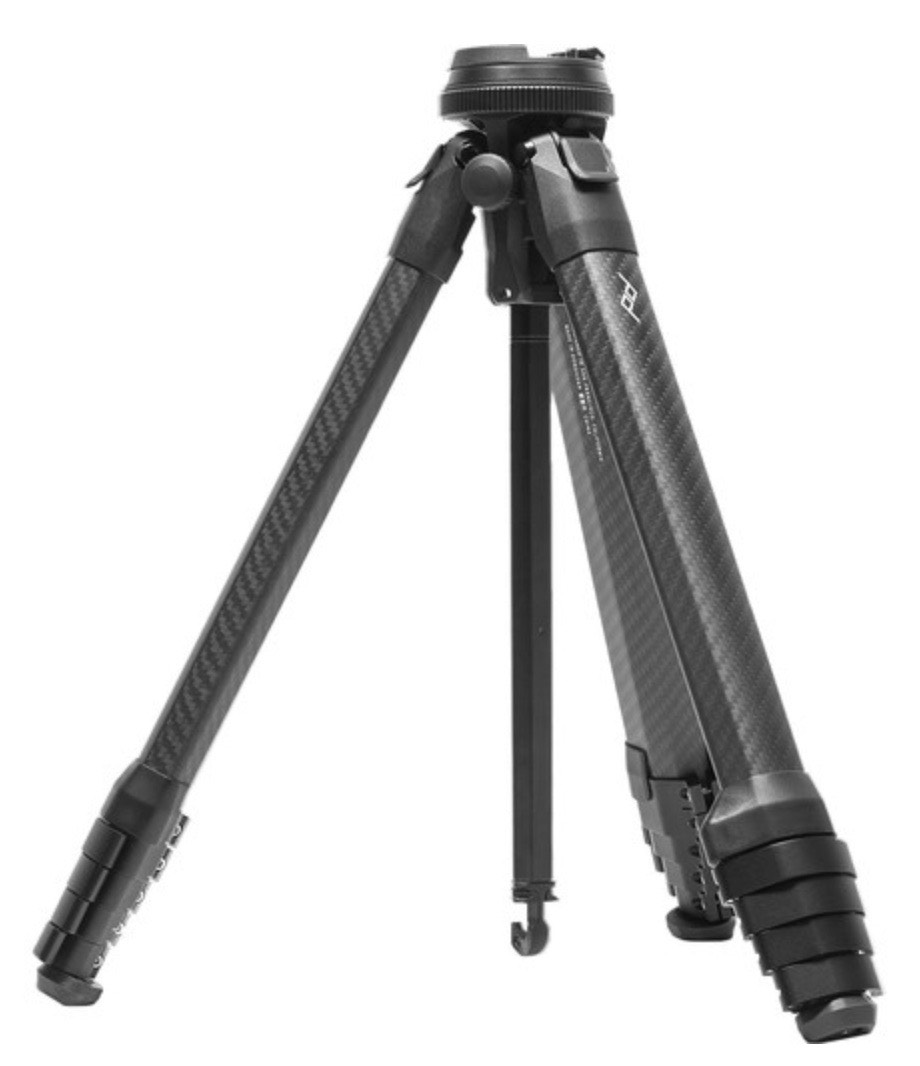
- Pack Size — 8" circumference, 16" maximum length (includes supplied head). This is the distinguishing trait of this tripod.
- Weight — 44.8 ounces, 1270g.
- Leg Rigidity — Using just two sections deployed, the tripod still has pretty solid rigidity, and the small amount of flex I can exert is dampened quickly. Each section beyond that weakens the rigidity enough so as to compromise the stability more. At full extension, I wouldn't put a heavy system/big lens on it. Height is 32" with two sections deployed, but you can get to 40" using the center post and still have a reasonably stable platform, as long as you aren't using a heavy camera/lens combo. No, it's not the right tripod for a 70-200mm or bigger user. It's a great tripod for my Z50 and kit lenses, making for a small travel kit.
- Minimum Height — 5.5" requires center post flip.
- Vibration — Surprisingly little shutter shock, particularly when not fully extended, but a high and long degree of vibration on leg tap.
- Field Cleaning — Requires removal of two screws with allen wrench. Slow, cumbersome, and tricky to clean.
- Center post/Head Rigidity — Center post is very rigid if locked down. Supplied head locks down tight, as well.
- Configuration Flexibility — Fair. Legs have two positions (angled and flat). Center post can be flipped with tools.
- Configuring Speed — Fast for extending if you do it as a group, average for adjusting.
- Maximum Height — 60".
- Supplied Head — An odd head that's fiddly to get accurately set and takes some getting used to. Also, the top plate is really designed for Peak Design clips, not Arca Swiss plates, though you can remove two small screws and do so.
- Load Capacity — 20 pounds. I wouldn't put 20 pounds on this tripod, not even close.
- Number of CF Layers — Unspecified.
- Price — US$600. Comes with nice travel case that's a little too tight, which makes it fiddly.
- Source: purchased.
Thom's synopsis: With two sections extended (about 32" to camera plate), this is a rigid tripod that I'd probably be happy to put a four pound load on. With another leg section extended, you get clear flexing, and vibration starts to become an issue. The non-circular design of the center post actually makes center post extension more usable than most: it locks solid and dampens vibration quickly. So call the tripod very usable at up to 40". Declining beyond that. Nice touch: the two allen wrenches supplied have a nice tuck-away spot on one of the legs, so are always handy.
Overall, you buy this tripod because of its extremely small pack size. Probably the most pack-friendly I've seen that I could envision using. Pricey, takes some getting used to, isn't a great eye-level tripod, but certainly one of the more interesting options. I bought one, but I don't really recommend it to others unless they can deal with those three issues. Moreover, it's expensive; if you can live with something a little bigger, less expensive options are available that are as good up to that 40" mark (and beyond).
___________________________________________
Gitzo 2545T
This is a Series 2 Traveler, which is designed to compact down a little more for travel (partly by folding back over the center post).
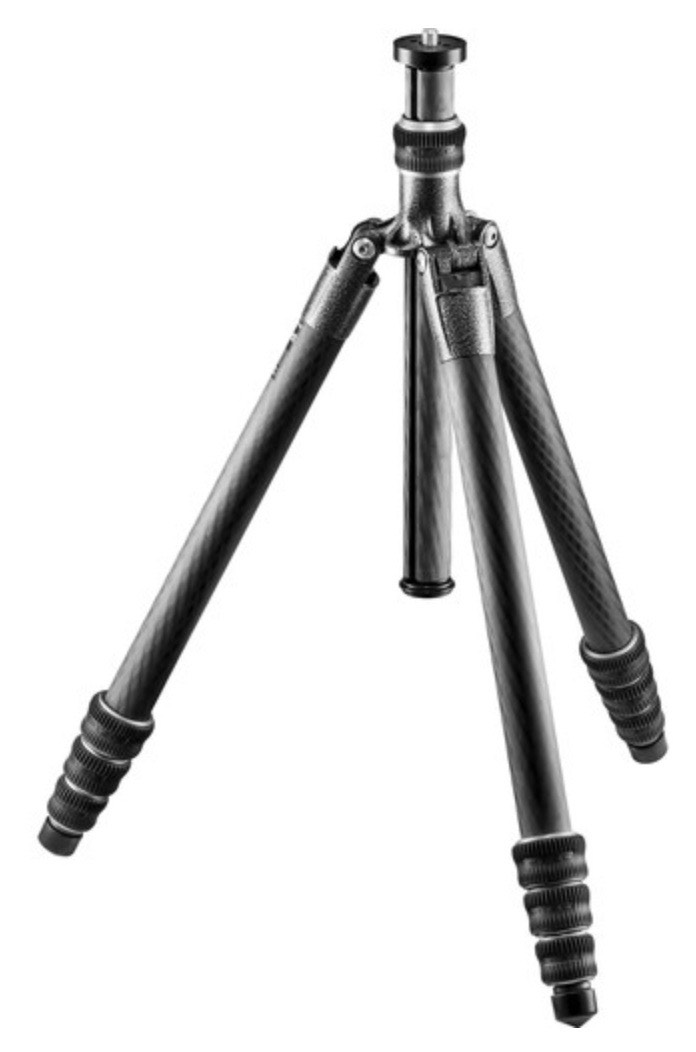
- Pack Size — 11" circumference, 18" length (back folded, otherwise 21").
- Weight — 47.2 ounces, 1340g,
- Leg Rigidity — One of the better choices fully extended. Yes, there's a little bit of leg bend, but emphasis on the "little." Likewise, the center post extension is solid when locked down. Thus, it's one of the few of the smaller tripods I tested that you might use at eye level (~61"). 200/300mm and a biggish body are fine on this tripod.
- Minimum Height — 8.7" with extra (supplied) short center post.
- Vibration — A surprising, but short vibration to shutter shock, excellent leg dampening on tap.
- Field Cleaning — Leg joints unscrew, allowing easy fielding cleaning. No real grease to worry about. Don't lose the plastic bushing at the top of the leg and make sure to get it back into the correct position before re-assembly.
- Center post/Head Rigidity — Excellent, plus you have the shorter post available, as well.
- Configuration Flexibility — Not great. Legs have two positions (angled and near flat). Low position requires center post switch.
- Configuring Speed — Slow for extending and fair for adjusting. When dry (and you should keep your tripod legs dry), the legs have too much friction into the joints and this makes adjustment slow and cumbersome. The big rubber joint grips are solid in use when wet, though.
- Maximum Height — 61"
- Supplied Head — None.
- Load Capacity — 26 pounds.
- Number of CF Layers — 6x.
- Price — US$550.
- Source: two-month loan from B&H.
Thom's synopsis: Gitzo has always made good tripods, and their current lineup still reflects this. I guess if I had a complaint, it's that Gitzo has pretty much stuck to their original designs without picking up on as much of the innovation that their competitors have done over the years. Yes, this is a "fold back over center post" tripod, which was first done by others, and yes, their leg lock grips have been improved, but a lot of small touches are missing (e.g. more position flexibility, tool storage, bubble levels, and much more). Moreover, the "bag" you get is mostly just a cloth protector, and most of the other companies are providing real carry bags now. You buy this tripod pretty much for its sturdy rigidity coupled with its small pack size. Indeed, in terms of pack size/weight, this tripod is nearly as good as it gets in that respect. But Gitzo pods tend to be pricier than the equivalents.
______________________________________
Geekoto CT25 Pro
One of my test choices was a tripod that caught my eye because of the price and specs. US$110 for a carbon fiber tripod? That can't be right. And it includes a ball head? The Geekoto is another of those fold-over-the-centerpost designs to preserve pack size, too. Something seemed wrong here, because my old MeFoto cost far more.
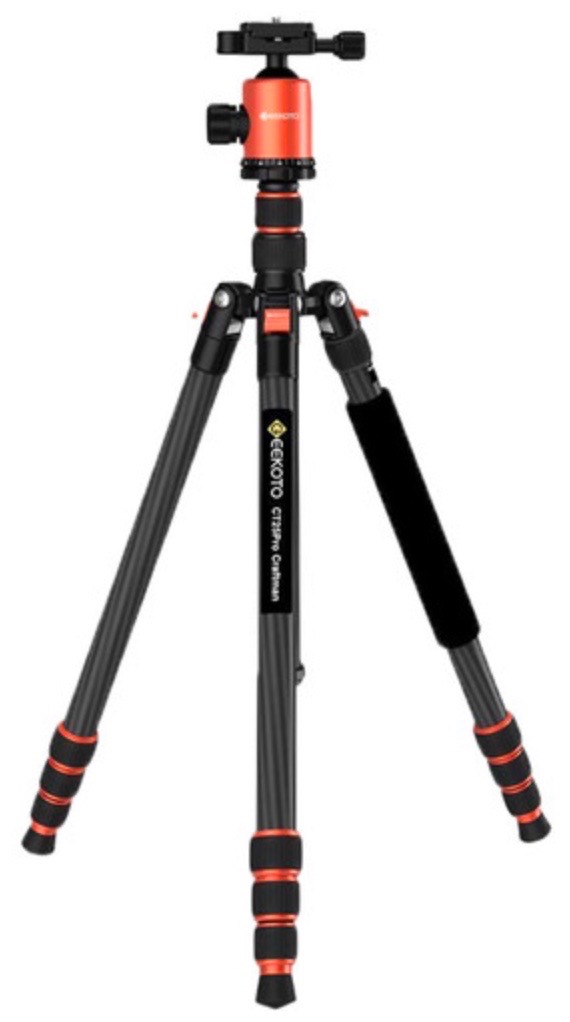
- Pack Size — 12" circumference, 20" length (with head).
- Weight — 54.3 ounces, 1540g, includes head,
- Leg Rigidity — With the bottom section not extended, very good rigidity, better than my meFoto. This puts the camera bottom at about 44", and I wouldn't be afraid to do a little center post extension. 200/300mm with a moderate body works with care.
- Minimum Height — 19", though you can, with some difficulty, reverse the center post and shoot down to ground level.
- Vibration — Very little shutter shock, but a tap on the leg fully extended produces a very long ring effect. Not the worst in this test, but enough to be careful when working around the tripod while photographing (and in gusty winds).
- Field Cleaning — Yes. Simple, though old style.
- Centerpost/Head Rigidity — Surprisingly good considering it's a two post design (and thus has two joints. Modest extension is fine. It's only fully extended that I felt it left something to be desired.
- Configuration Flexibility — Very good, with three leg angles, longish center post plus a monopod capability.
- Configuring Speed — Not great, not bad. The joint rubber is smaller than on most of the other pods, and when wet, slippery. There's no complexity internally in the joint to help guide extension as there is in most, so I wonder how that will play out over time. I found that I had to pay closer attention to unlocking and locking the joints.
- Maximum Height — 79", but that's using the center posts.
- Supplied Head — Geekoto ball head with Arch-style plates.
- Load Capacity — 26.5 pounds .
- Number of CF Layers — Unspecified.
- Price — US$110.
- Source: two-month loan from B&H.
Thom's Synopsis: Okay, if you want to go small, you can go really small with the Peak Design and pay top price, or you can go a little bigger with the CT25Pro Craftman and only give up only one-fifth the dinero. In terms of support, they're similar, though I'd give a nod to the CT25Pro, as it has a little less shutter shock vibration and somewhat shorter tap leg vibration than the Peak Design. Indeed, this tripod seems better than my MeFoto Globetrotter Carbon Fiber, for half the price.
And here's a surprise: it has two center post sections, and those remove and can be added to one of the legs that unscrew to become an 81" monopod! That leg has a grip, but it's a cheap foam, not solid rubber. You can see cost cutting if you look, but for the most part that doesn't cause functional issues. Where the legs attach to the top plate seems like it could be a weak point if you really torture the tripod. I've broken sturdier plates. This is the best low-cost tripod option I've seen to date. For it's price it has lots of extras and not as many drawbacks as you'd find in similar-price competitors. This is a tripod I think I'll purchase and subject to a little Thom Torture in the future. Because if it can endure that, it'll replace my meFoto, even though it packs somewhat bigger.
___________________________________________________
FotoPro X-GO Max
I encountered FotoPro first at a trade show, and was impressed with their products, so I wanted to include one of their tripods in this test. I picked one of their lower end models partly because of how impressed I was with it, and this one includes the FPH-62Q Ball Head in the very reasonable price.
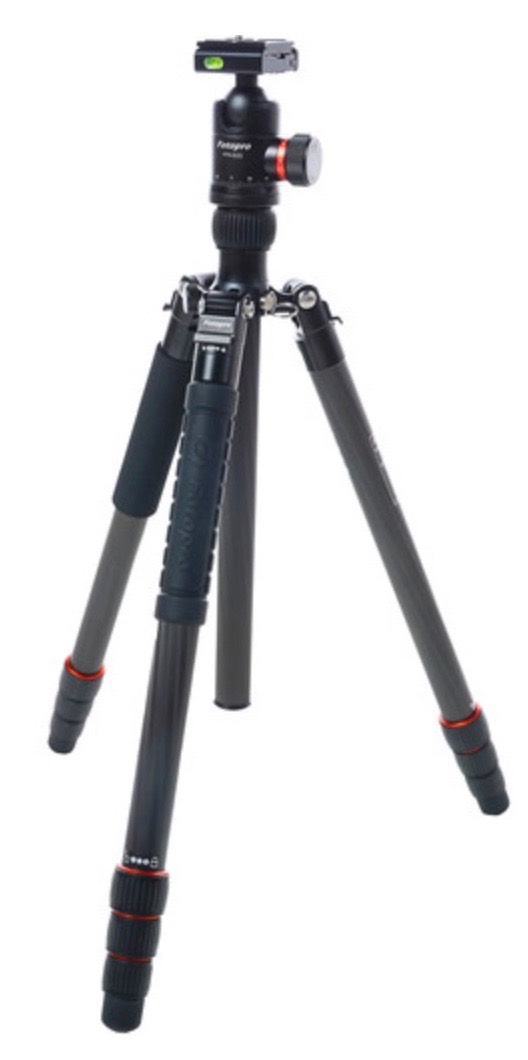
- Pack Size — 13.5" circumference, 20" length (with head and legs reversed)
- Weight — 63.9 ounces, 1810g (includes head)
- Leg Rigidity — Excellent with two leg sections extended (44"), but still good with all three extended if you don't splay the legs out into one of the extended angles. Center post extension was very good, and it adds 11". 200/300mm is about the biggest lens I'd put up top with a biggish body.
- Minimum Height — 18.4". Ugh. Though there is a mounting stud on the bottom of the center post, so you could flip the head to the bottom of it and get to ground level.
- Vibration — Not bottom of the pack, not top of the pack. Shutter shock handling was generally excellent, but leg tap had a bit of an extended vibration to it, though nowhere near as bad as the Peak Design.
- Field Cleaning — Joint is removed easily, but the internal sleeve has a coating on it that you don't want to remove. If you know to align the sleeve properly, on and off is simple.
- Center post/Head Rigidity — Very good. Just a bit short of what some of the best tripods had.
- Configuration Flexibility — Very good. Three leg angles are supported. But more interestingly, you can unscrew one leg and use it as a monopod or hiking stick (it has a nice rubber grip). You will need to carry an extra mounting stud with you to mount the head directly on the monopod leg, though.
- Configuring Speed — Good for extending, very good for adjusting. The leg joints require only a small twist to unlock, unlike some of the competitors. It would probably get better marks if it weren't for the fact that the grips aren't as grippy when wet.
- Maximum Height — 67.6".
- Supplied Head — FPH-62Q Ball Head. This is a smallish ball head with an Arca Plate system up top. For a small head, it seems pretty decent, with controllable friction and a good lock. The three bubble levels are little hard to see and use.
- Load Capacity — 25 pounds.
- Number of CF Layers — Not specified.
- Price — US$270.
- Source: two-month loan from B&H.
Thom's synopsis: This tripod was a bit of a surprise, as its capability at its price point is excellent. I'd put this one in the bargain category as long as you're careful about not putting too much weight up top or extending it fully. My Z6 II with the 70-200mm was about the max I'd want to put on it extended. Up to this point, the meFoto Backpacker has been my minimal useful tripod at a lowish price, but I'd take this one above that, even though it doesn't quite pack down to the same size. It's just sturdier at similar extensions, has a better head, and is just as useful in other configurations (e.g. monopod, strap ring, bubble levels, etc.). Curiosity: one leg has a foam "warming" pad, the removable monopod leg has a rubberized hiking grip, while the final leg has none; these legs must be envious of one another.
_______________________________________________________
Manfrotto 190
I wanted to test a relative to the Manfrotto legs I referred to in my original article, and found that they now make both aluminum and carbon fiber versions of their basic legs. I chose the carbon fiber so as to be as close to possible as the other choices I made in selecting test candidates. Lots has changed over the years. The leg locks and other aspects have been completely redesigned and improved, for example.
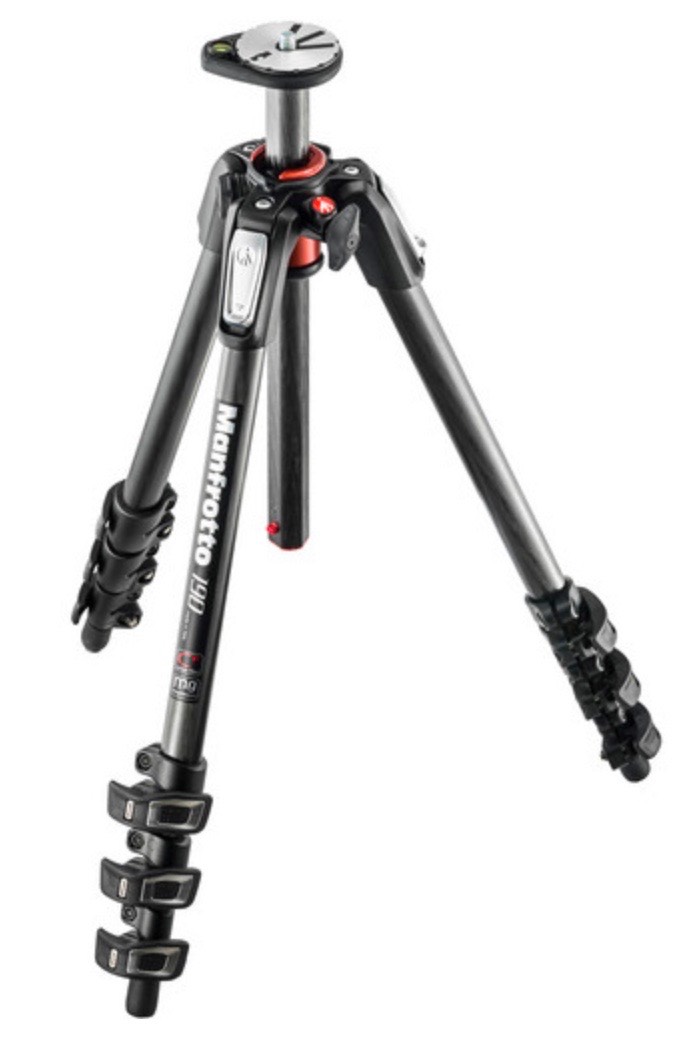
- Pack Size — 13" circumference, 21" length.
- Weight — 56.4 ounces, 1600g.
- Leg Rigidity — Very good. One of the more sturdy legs I found. There's an important sub-point here: casual observation suggested I should expect low rigidity. The bottom leg section is one of the thinnest and longest in this test. But close examination and testing says the opposite. This has a lot to do with the redesigned leg section locks, which seem to do a very good job of keeping joint issues from showing up.
- Minimum Height — 3.2". This requires a weird center post adjustment (it goes out sideways) that isn't particularly stable in my view. You can push down on the center post and get some stability back, but that introduces a complication.
- Vibration — As with rigidity, I was a bit surprised. This tripod was a very good performer both with shutter shock and avoidance of leg vibration.
- Field Cleaning — I'm not sure it's something you should try, and it would certainly require a tool. Springs are involved within the joints, among other delicates.
- Center post/Head Rigidity — Surprisingly good considering there's a plastic part in there (for that center post to go horizontal). I wonder about the long-term integrity of that part, but for regular center post work it seems fine.
- Configuration Flexibility — Perhaps one of the more flexible ones, with 3+ leg positions and a tilting (!) center post. There's also a mounting point at the side of the top plate and a bubble level that can be rotated to any horizontal orientation.
- Configuring Speed — Somewhat slow to set up, slow and a little finicky to adjust.
- Maximum Height — 53".
- Supplied Head — None.
- Load Capacity — 15.4 pounds.
- Number of CF Layers — Not specified.
- Price — US$500.
- Source: two-month loan from B&H.
Thom's synopsis: If you like flip lever joints, these are some of the sturdiest I've ever encountered, and it's abundantly clear when they're locked and unlocked. While the leg sections looked smaller in diameter than some of the other similar tripods, they seem reliably sturdy and not prone to vibration. The centerpost gimmick seems a bit like that to me, a gimmick. This set of legs is about at the top of the Manfrotto travel options; you can find simpler, lower-cost versions, such as the 190go!.
___________________________________________________
Oben CT-2491
"You're on steady ground" is one of their marketing messages. Well, if so, why not just put my camera down on the ground? ;~) Oben is a B&H co-brand.

- Pack Size — 12" circumference maximum, 25" length minimum (no head).
- Weight — 56 ounces, 1590g.
- Leg Rigidity — With two sections extended, the tripod is excellent in rigidity and nearing 4' in height. With the last leg section extended the rigidity declines to good. With care I'd use one of my bigger lenses on this tripod, but I'd be doing that without full extension.
- Minimum Height — 6", legs fully spread, no centerpost used.
- Vibration — A quite reasonable performance, about the same as the smaller Gitzo that was my main companion for many years. Some shutter shock was seen fully extended with the 70-200mm, but fairly fast vibration dampening.
- Field Cleaning — Leg joints unscrew ala Gitzo, allowing easy fielding cleaning. But note that there is grease in those joints: you don't want to remove that. Also, don't lose the plastic bushing at the top of the leg and make sure to get it back into the correct position before re-assembly.
- Center post/Head Rigidity — With a lot of hand pressure on the tightening lug, you can get the center post completely rigid. With just normal tightening, I found some play in the center post.
- Configuration Flexibility — Good. Supports three leg angles.
- Configuring Speed — Slow for extending, average for adjusting. The leg locks rotate and are about the same as the old Gitzo ones, which is to say just a little on the finicky side at times.
- Maximum Height — 62.5" with legs alone, center post adds 10".
- Supplied Head — None.
- Load Capacity — 39.6 pounds. Yes, I'd put a heavier camera and lens on this tripod, up to a point.
- Number of CF Layers — 6x.
- Price — US$500 (but sometimes on sale; at the time I received it, it was on sale for US$300, which would make it a clear bargain).
- Source: long-term loan from B&H.
Thom's synopsis: Pretty much a solid Gitzo knockoff, both in design and in capability. Feels decently made and has a few nice touches to it (retracting spikes on feet, wings on the centerpost twist lock, bubble level). The included bag is far bigger than necessary, apparently designed to accommodate a really big head. Does require you to fully tighten the centerpost to get best rigidity, and that takes some hand strength. Yes, I could live with this tripod for much of my work.
_____________________________________
Robus RC-5570
I also wanted to test at least one "big" tripod this round. The Robus is about the largest tripod I'd consider for travel. Heck, even for studio work I can't see the top of the camera when extended. One other aspect of this tripod: it has no center post but a removable top plate that can be replaced by a video bowl.
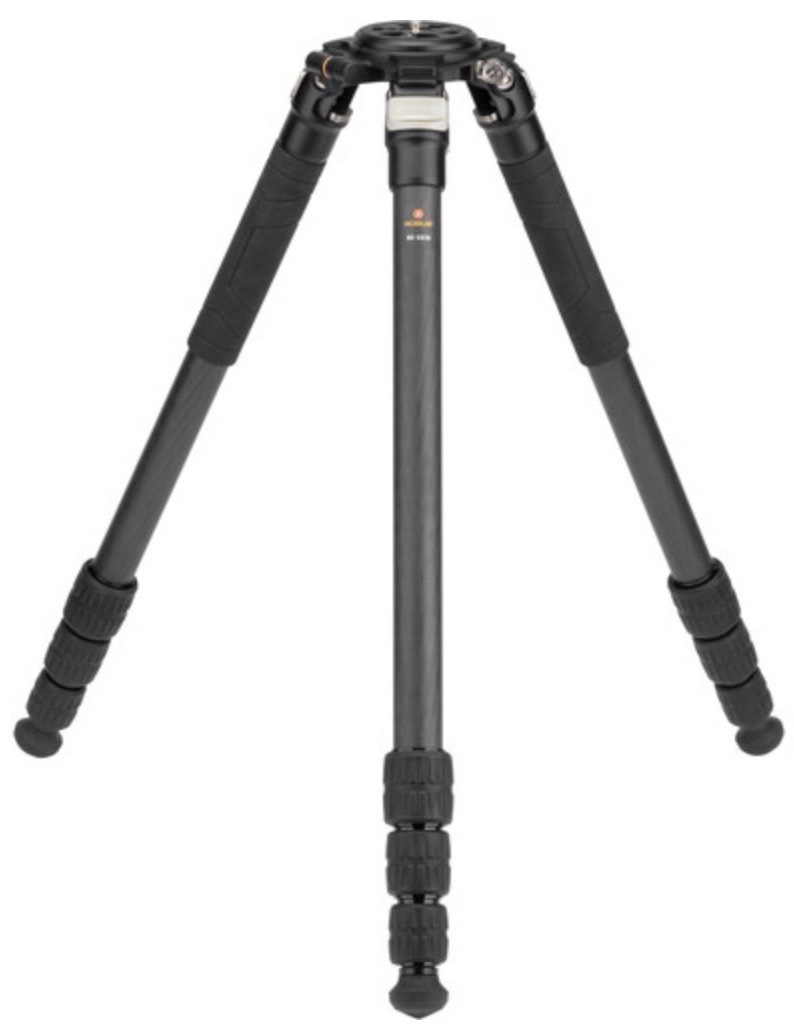
- Pack Size — 16" circumference, 26" length. Wider at shoulder (top plate) than leg bottom.
- Weight — 88 ounces, 2495g
- Leg Rigidity — Excellent when joints tightened properly. Handles long, heavy lenses well.
- Minimum Height — You have to splay the legs out fully, but believe it or not the top plate gets down to 4". That's remarkably good for a tripod that goes as high as this one, but it does mean you've got legs splayed on the ground to deal with.
- Vibration — As you might expect, shutter shock is well dampened, and even fully extended the leg vibration is very good, with only a modest "ring" after tap.
- Field Cleaning — Can easily be field cleaned, but don't lose the plastic sleeve over the section end.
- Center post/Head Rigidity — None. With my biggest lenses on a gimbal head on this set of legs, I felt quite comfortable.
- Configuration Flexibility — Very good for a tall pod. Three leg angles, plus the ability to replace the top plate with a video 75mm bowl (included) and the bottom leg tips can be replaced with spikes (included).
- Configuring Speed — Mid-range. Not slow, not fast. The leg angle lock is big and easily adjusted. But the joint tightening rubber gets slippery when wet.
- Maximum Height — An excellent 70".
- Supplied Head — None.
- Load Capacity — 55 pounds.
- Number of CF Layers — 10x.
- Price — US$540 (this is why I wanted to include it in this test, as it's at the top of the leg price range I was testing, but is a beefier, taller tripod than the rest).
- Source: long-term loan from B&H.
Thom's synopsis: This is the kind of tripod I'd be carrying with my gimbal head (B&H also lent me an Oben GH-30 gimbal for just that kind of test, which produced as stable a gimbal set as I've ever used). Getting the top plate locked down (or video bowl) is a little finicky, but everything else works the way I'd want. Two legs have rubber gripping on their top section, and there's a huge hook hanging from the center plate. One bubble level on the leg shoulder. If you can put up with the extra weight and packing size, this is a solid, affordable tripod that's good for those big lenses. Better than the older, big Gitzo I've been using for years, though the Robus also packs a tad bit bigger (at the shoulder, due to the bowl capability spreading the top plate wider).
___________________________________________________
Benro TMA48CXL Mach3
The beefiest, biggest tripod of my test. I wanted to test one of the heftier Benros because I usually encounter the smaller, lighter versions with my workshop students, and this bigger model still fit into my price parameters.
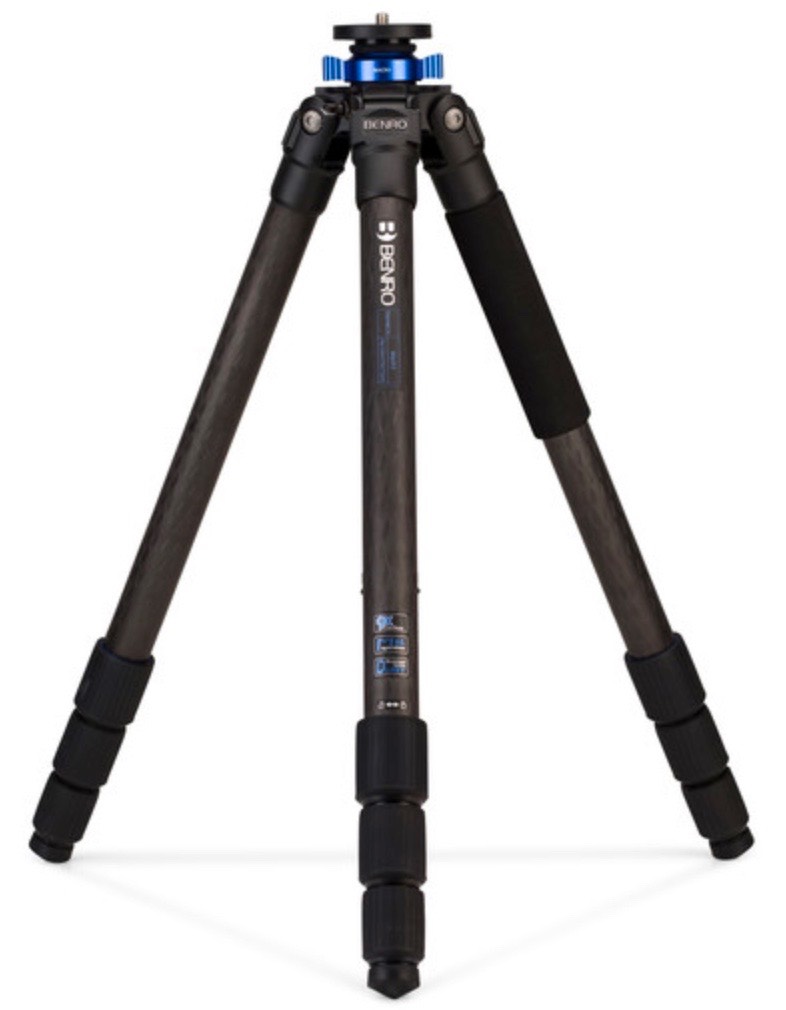
- Pack Size — 14.5" circumference, 27" length (no head).
- Weight — 91.7 ounces, 2600g.
- Leg Rigidity — The way I'd use this (top two sections extended), it's excellent. About as good as you can expect. That puts the top plate at 53" (ball or gimbal head would extend that). You can add some center post and not lose any rigidity. Not afraid of putting any of my gear up top.
- Minimum Height — Not great. 16" with short column (included).
- Vibration — One slight surprise here. Shutter shock was handled with aplomb. Leg tap resulted in one clear ring: tap, echo, stop. I've never seen that before (one echo, stop). So the dampening abilities are good, just not perfect.
- Field Cleaning — Yes, and the joint is likely to be resistant to stuff getting into it due to its long sleeve. Don't lose or break the inner sleeve while cleaning, though.
- Center post/Head Rigidity — As solid as center posts get. I'm comfortable putting anything I own up top.
- Configuration Flexibility — Straightforward, with three leg angles. Comes with spikes and rubber feet.
- Configuring Speed — Good to setup up, good to adjust. The center post has big wings to grab/push for adjustment. The big rubber joint grips are easy to grasp with your whole hand. They do get a little slippery when wet, though.
- Maximum Height — 71" without center column, 83" with.
- Supplied Head — None.
- Load Capacity — 44.1 pounds.
- Number of CF Layers — 9.
- Price — US$495.
- Source: two-month loan from B&H.
Thom's Synopsis: A really well made, nicely finished "big" tripod. Like the Robus, the Benro would be a good choice for big lenses and/or gimbal head use. One leg has a foam pad on the top section for comfort while carrying. It's the largest to pack and heaviest tripod in this test, but comes at an excellent price for the stability it produces.
___________________________________________________
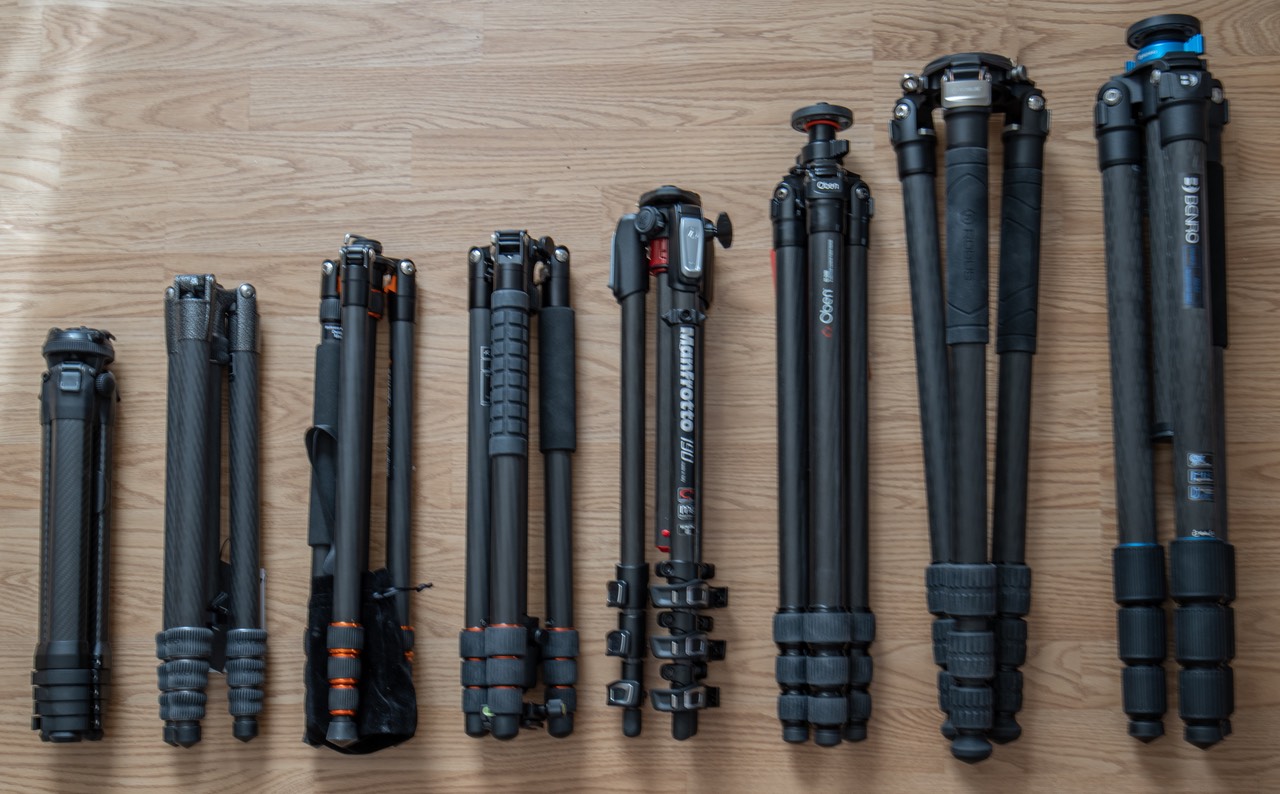
So there you have it. You've been asking me for years for recommendations on tripods that won't break the bank, and here I've given you eight possible choices, one of which should probably be just about right for you. Note that many of these tripods come in different number of leg sections and have small/bigger brothers with similar tendencies, so you have quite a range of choice to contemplate.
If you're using big lens and heavy equipment, stick to the Benro or Robus if you can (two far right). If you can deal with lots of compromises to absolutely minimize pack size/weight, the Peak Design (leftmost) is worth looking at, though I'd personally sacrifice a bit of size and weight for the Gitzo, Geekoto, or FotoPro most of the time. The Manfrotto and Oben are more the jack-of-most-trades choices here.
You're probably wondering about my Really Right Stuff (RRS) Versa and my big Gitzo tripods, which have been my workhorses for years. Yes, I still use these two most of the time, though I'm now thinking about replacing my large Gitzo in the studio with the Robus, which is a bit more flexible for video work and can take the camera up higher. I'm not sure I'd gain any stability by swapping the Robus for the Gitzo, so I'd only be making a minor upgrade there (though at a lower cost). But the RRS is pricey: you pay a lot more for a little more is how I'd call it today after using these mid-priced tripods for two months.
Support this site by purchasing from the following advertiser:
